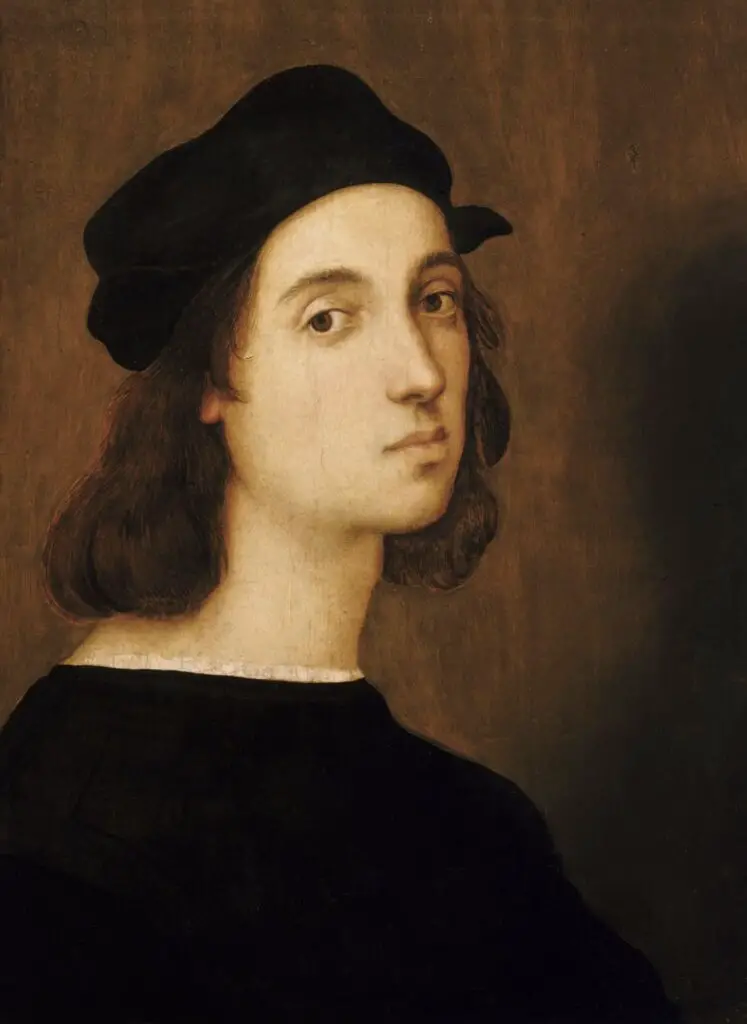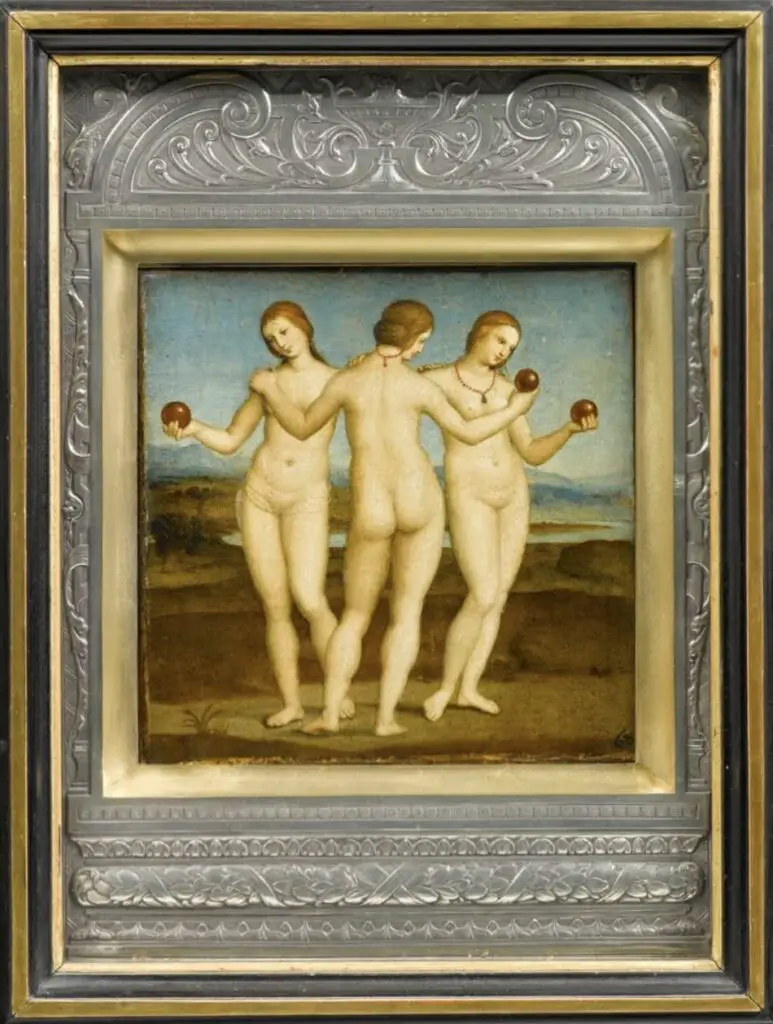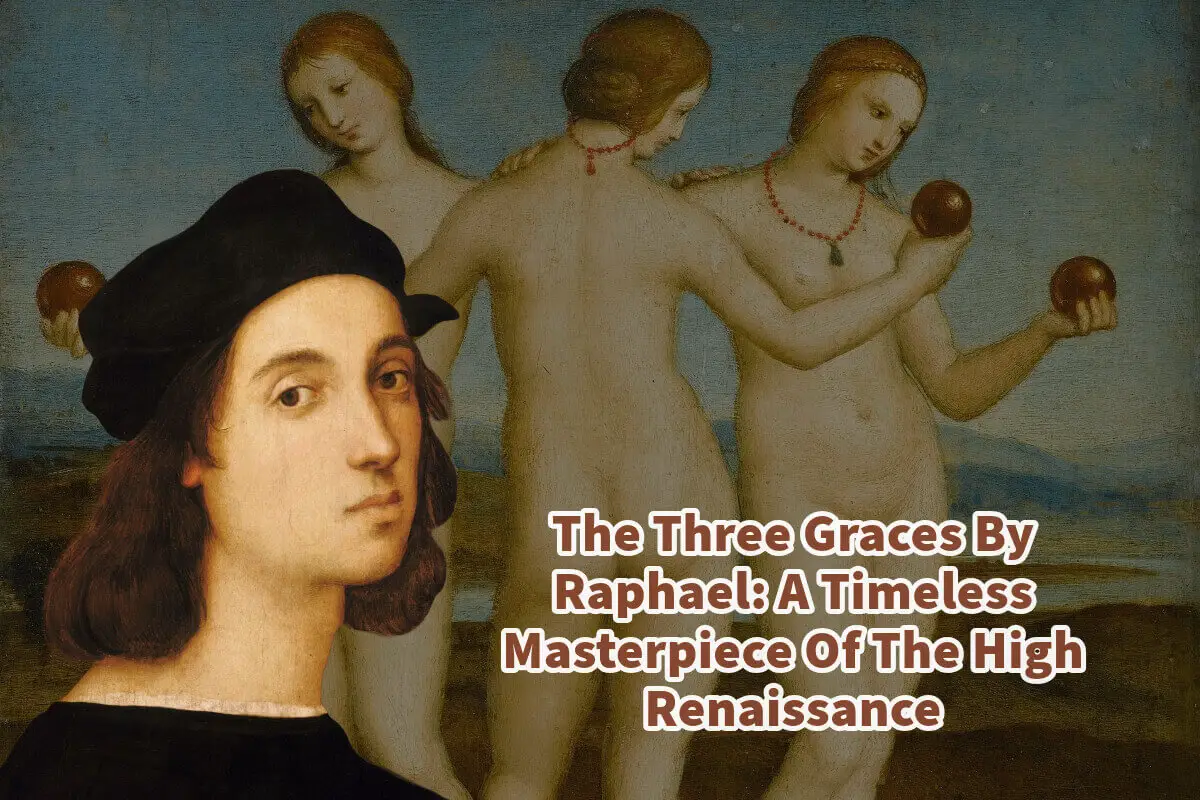Among the vast repertoire of Renaissance art, Raphael’s “The Three Graces” stands out as an epitome of classical influence melded with artistic innovation.
This painting, completed in the early 16th century, is a significant work in Raphael’s oeuvre and within the broader context of Renaissance art. Read on to delve into why this piece is considered so important and what it tells us about its time’s cultural and artistic currents.
Table of Contents
- Historical Context And Description Of Raphael’s Three Graces
- Technique And Innovation Of The Three Graces
- Enduring Influence Of Three Graces
- Related Questions
Historical Context And Description Of Raphael’s Three Graces
“The Three Graces” depicts three figures, commonly interpreted as the mythological Graces, goddesses of charm, beauty, and creativity. They stand closely together, each holding an apple.
They are set against a stark, dark backdrop that accentuates the softness of their forms and the harmony of their interconnected poses. The figures are arranged in a tight circle, with their hands delicately touching, symbolizing unity and the interdependence of their virtues.

Artistic Significance Of Raphael’s Three Graces
Raphael’s “The Three Graces” is celebrated as a pinnacle of artistic achievement for many reasons. Not only is Raphael acknowledged as one of the great masters of the Renaissance, but this particular painting stands out as a quintessential example of his artistic prowess.
The painting showcases his skill in combining classical ideals of beauty and harmony with the innovative techniques of the High Renaissance. This work exemplifies how Raphael’s artistry transcends mere technical mastery, embodying a deeper understanding of beauty and human emotion that resonates through the ages.
Embodying Neo-Platonism
Raphael’s painting celebrates Neo-Platonic thought, which sought to elevate the spiritual and intellectual over the physical and mundane. By nature, the Graces blend physical beauty and inner goodness, bridging earthly and divine qualities.
This philosophy influenced Renaissance artists to seek idealized forms and themes that reflected a more profound moral philosophy.
Aesthetic Perfection And Composition:
“The Three Graces” is widely admired for its composition and the harmony it achieves through symmetry and balance. Raphael’s ability to convey softness in the figures’ bodies and serene expressions on their faces demonstrates his mastery of human anatomy and emotion.
This reflects the high standards of aesthetic achievement during the Renaissance and Raphael’s style, which balanced detailed physical observation with an idealized aesthetic.
Cultural Resonance:
When Raphael painted “The Three Graces,” there was a revived interest in classical antiquity, and artworks often incorporated themes from ancient Greek and Roman mythology.
By choosing the Graces as his subject, Raphael tapped into the zeitgeist, aligning his work with the tastes and philosophical inclinations of his patrons and the intellectual elite of his time.
Technique And Innovation Of The Three Graces
Raphael’s “The Three Graces” exemplifies his masterful handling of technique and style, marking it as a distinguished work within the High Renaissance.

Raphael Uses The Sfumato Technique In The Three Graces
In this painting, Raphael employs the technique of sfumato, an artistic method perfected by Leonardo da Vinci, which allows for the seamless blending of colors. This technique is crucial in achieving the delicate transitions between hues on the canvas, contributing to the ethereal and soft appearance of the figures.
The sfumato not only enhances the dreamlike quality of the painting but also adds a layer of depth and realism to the figures, as it subtly outlines muscle and bone beneath the skin without the use of harsh lines.
Balanced Composition Of Three Graces Painting
Beyond sfumato, Raphael’s style in “The Three Graces” is further characterized by his balanced composition and the graceful postures of the figures, which exhibit an elegant simplicity yet a complex arrangement of forms and gestures.
Each Grace is positioned so that its bodies and limbs create a fluid, circular motion, drawing the viewer’s eye inward from one figure to the next in a harmonious loop. This circular composition reflects the Renaissance ideal of perfect geometry and balance.
Raphael Used Chiaroscuro
Moreover, Raphael’s use of chiaroscuro—the contrast of light and shadow to achieve a sense of volume in modeling three-dimensional objects and figures—is evident. It adds a sculptural quality to the painting.
This technique, combined with sfumato, allows Raphael to imbue the figures with a soft glow, highlighting their divinity and purity, essential themes in Renaissance art. His color palette is also a testament to his style, often using muted, harmonious colors that complement the tranquil and idealized nature of the subject matter.
Raphael’s techniques in “The Three Graces” demonstrate his genius and encapsulate the broader advancements of the High Renaissance.
Raphael communicates a deeper understanding of human beauty and the interconnectedness of form, technique, and expression through his art. His innovative approach and meticulous attention to detail make “The Three Graces” a masterful portrayal that continues to enchant and engage scholars and art lovers alike.

Enduring Influence Of Three Graces
“The Three Graces” has had a lasting impact on art and culture beyond the Renaissance. It encapsulates the ideals of beauty and harmony that continued to inspire artists centuries later.
The theme of the Graces has been revisited repeatedly in European art, underlining the timeless appeal of classical motifs and their adaptability to various artistic periods and personal interpretations.
Raphael’s “The Three Graces” is more than just a visual treat; it is a rich, layered work that offers insights into the philosophical and aesthetic values of the Renaissance. Through this painting, Raphael showcases his formidable artist skill and ability to embed complex intellectual ideas within compelling visual forms.
As such, “The Three Graces” is a vital piece in studying Renaissance art. It continues to draw admiration for its beauty and depth and maintains its place as a significant work in art history.
Anita Louise Art is dedicated to art education, great artists, and inspiring others to find and create their art. We love art that uplifts and inspires. #ArtToMakeYouSmile! #ArtToMakeYouHappy!
If you want to see any of my art, you can find out more by clicking here. If you are interested in what inspires me and my paintings, you can discover more by clicking here.
We have a free newsletter and would love you to be part of our community; you can subscribe to the newsletter by clicking here. I would be happy to talk to you if you have any questions. You can reach me, Anita, by clicking here.
Subscribe to our Anita Louise Art YouTube Channel with great videos and information by clicking here.
Join us for our podcast “5 Minutes With Art.” Spend just 5 minutes a week with us to discover and learn about great art and artists. You can find out more about our podcast by clicking here.
Related Questions
Did Raphael, Michelangelo, And Leonardo Ever Meet In Person?
Leonardo da Vinci, Michelangelo, and Raphael are considered some of the most influential artists ever. They were all Italian artists who flourished during the Renaissance.
Records show that Michelangelo, Leonardo da Vinci, and Raphael would have known each other. But not all of their relationships were easy; some were filled with jealousy and rivalry.
By clicking here, you can learn more by reading Did Raphael, Michelangelo, And Leonardo Ever Meet In Person?
24 World Famous Painting Names And Artists’ Masterpieces
Step into a visual odyssey where each brushstroke echoes across centuries, and each hue narrates untold emotions. Have you ever wondered why some art pieces seem to command your attention, whispering secrets of bygone eras or evoking feelings you didn’t know you had? It’s not just about vibrant colors, intricate patterns, or revolutionary techniques.
By clicking here, you can learn more by reading 24 World Famous Painting Names And Artists’ Masterpieces.
36 Most Famous Paintings In Art History And Why They Matter
All art is a great and powerful motivator. Art, when done right, can change lives and change our moods.
Over the years, art has been a key in almost every society and time frame. So, understanding art through the ages and some of the world’s most influential art is essential as life’s influence continues. Read on as we explore some of the world’s most influential art pieces.
By clicking here, you can learn more by reading 36 Most Famous Paintings In Art History And Why They Matter.

